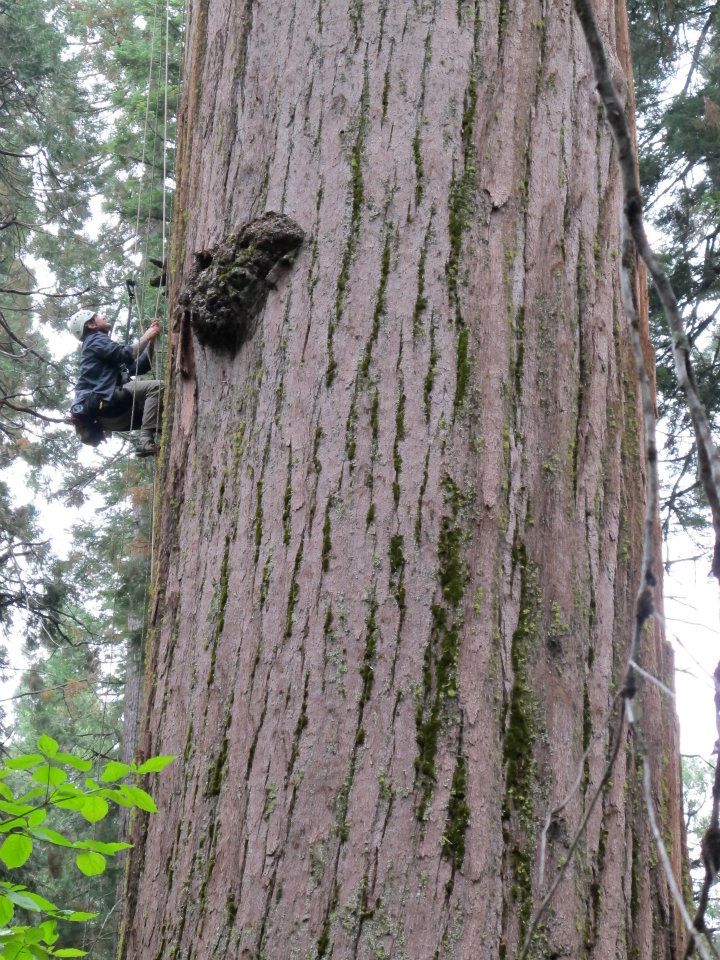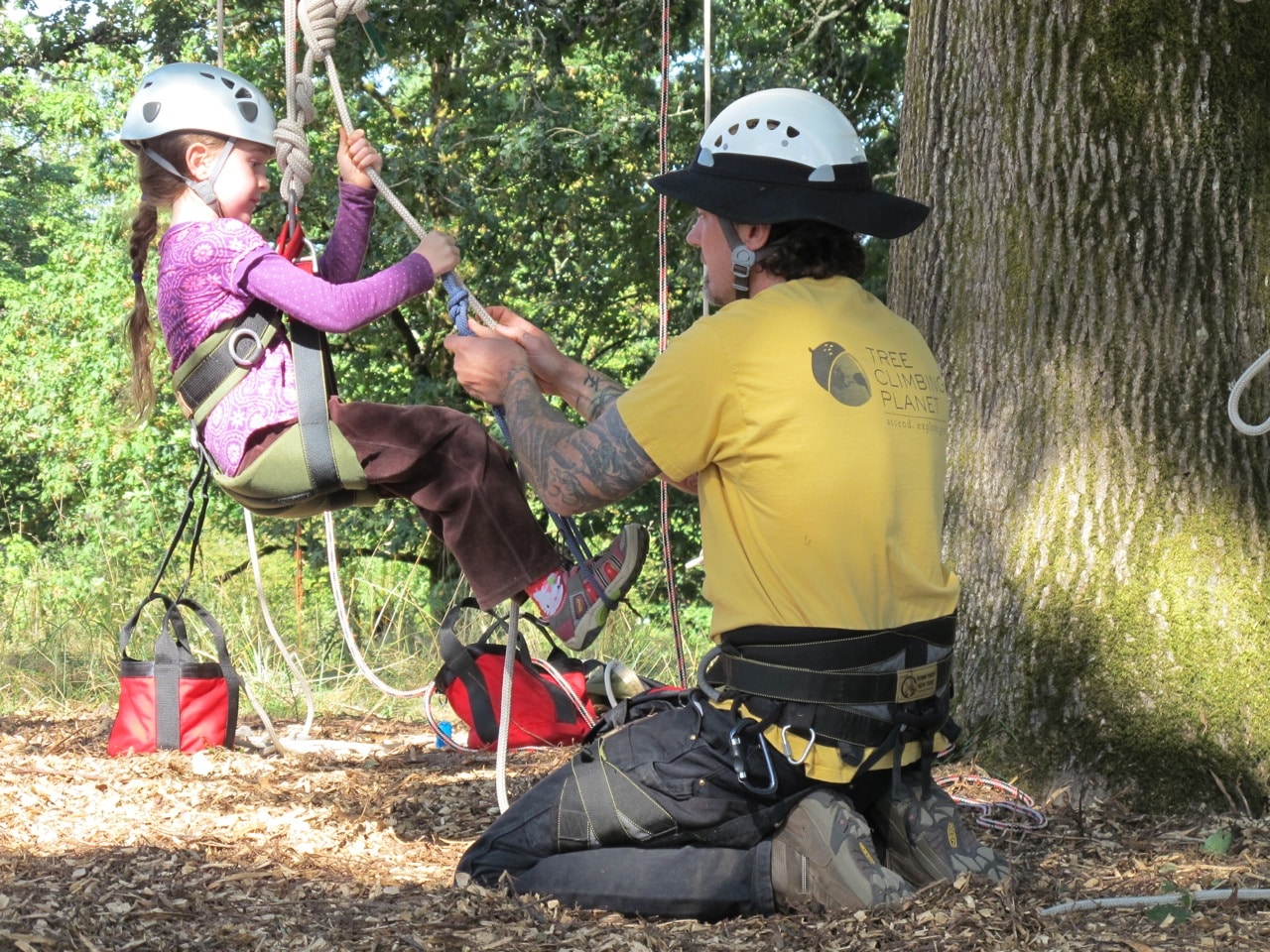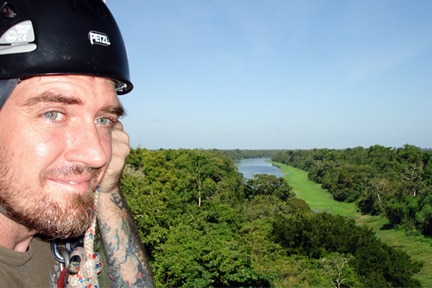
Once again we return to our So You Want My Job series, in which we interview men who are employed in desirable jobs and ask them about the reality of their work and for advice on how men can live their dream.
Every little kid wants to climb trees — it’s just built into us that where there are trunks and branches, we will ascend them. This desire, in many of us, never really goes away. I still get a hankerin’ to scramble up trees when I’m out hiking or even just in my backyard. For a few very fortunate people in our world, they don’t have to outgrow that desire, and better yet, have made a career of it. One of those people is Tim Kovar, founder of Tree Climbing Planet (a tree climbing school) near Portland, Oregon. While many men daydream about careers spent in the outdoors, very few attain that dream. It’s also even hard to know what the options for various outdoor careers may be. We had the pleasure to chat with Tim about his job, and how you can break into this unique field.
1. Tell us a little about yourself (Where are you from? How old are you? Describe your job and how long you’ve been at it, etc.).
I was born and raised in a small town just west of Omaha, Nebraska. Upon graduating from high school, I took off to explore the big city of Atlanta and started my vagabonding around the world. After 25 years of travel, Portland, Oregon and Nashville now serve as my base camps.
I’m a 43-year-old professional tree climbing instructor, guide, facilitator, and canopy access technician. I work with and teach others how to climb trees for a variety of reasons. This includes canopy researchers, photographers, eco-tourism operators, adventurers, authors, activists and arborists, along with the average Joe and Jane.
I’ve been climbing trees since I was four years old. About 20 years ago I was introduced to an activity called technical tree climbing – the use of a rope and saddle to explore the canopy – which led to my becoming an instructor and tree climbing mentor to hundreds of people around the world.
2. Why did you want to become a professional tree climber? When did you know it was what you wanted to do?
I was searching for an outdoor job, something completely opposite of my previous career as a chef. I was eager to get out of the kitchen and try something outdoors.
When I first started technically climbing trees, as an arborist, I found it physically and mentally demanding. It was a dangerous job that took me to a new office everyday (never a boring day when chainsaws are involved). I was excited about the work and loved the crew that I was learning from. One day my boss invited me out to his recreational tree climbing school. I had no idea that people (meaning adults) climbed trees for fun; I thought I was the only guy who never grew out of his passion to be up above it all.
When I arrived at the tree climbing school, I noticed people of all ages waiting to get on rope and explore the canopy of a 150-year-old white oak tree named “Nimrod.” There were kids as young as five and some that had 70+ growth rings on them. I remember sitting in awe watching two elderly ladies ascend 30’ up into the arms of Nimrod. It was then that I noticed there was this wide variety of people climbing the same tree. We had a 15-year-old punk rock kid climbing next to an eight-year-old girl, next to a grandma, next to a family from Germany.
I also witnessed something magical that day in Nimrod’s canopy; no matter what people’s political, religious, or philosophical demographic, they were all getting along and enjoying each other’s company. These strangers were sharing personal stories of climbing their favorite trees when they were children. This is when I knew that there was more to climbing trees than just climbing a tree; a unique type of camaraderie is manifested when people climb trees together.
I’ve always had a passion for the outdoors and introducing others to our natural world. A door was opened that day — one which would send me on a life path to help others experience nature in safe, adventurous, and profound ways.

3. A lot of people have probably never heard about being a tree climber as a profession. What are the different kinds of job opportunities open to tree climbers?
The most common job of a professional tree climber is as a working arborist or tree doctor. These guys and gals climb hazardous trees, making the world above our heads a little safer. They are also credited with doing great work in helping to take care of our urban trees. Other tree climbing jobs include tree house builders, zip line construction, canopy research assistants, as well as aerial rigging for film crews and photographers.
There is also a booming trend on canopy eco-tourism; this is where trained tree climbing guides take the public out for a day of tree climbing. These facilitated climbs can last an hour or for the more intrepid they can sign up for week-long expeditions exploring the trees of the Brazilian Amazon Basin. For some, the ultimate in a tree climbing experience is to catch some ZZZs in the trees, a.k.a. tree top camping.
Another recent option is a group in Japan that started a rehabilitation tree climbing program called Treehab, helping to give physically challenged kids a new perspective on life.
4. How do you become a professional tree climber? Is there a special certification you need to get, and does it differ according to what kind of tree climbing job you pursue?
Currently there is no governing body controlling the training of professional tree climbers. The arborist community follows OSHA regulations for tree care.
Working in the remote jungles requires different styles of climbing to produce the safest and most efficient methods of exploration. The best way to learn is to find a qualified school that has merit and can suit your climbing needs. But you must beware, as there are more and more rogue tree climbing schools popping up trying to make a quick buck. The main questions one should ask is where their instructor got their training from and if they are recognized by notable tree climbing schools such as Tree Climbing Planet, Tree Climbers International, and EarthJoy. Also ask for testimonies and referrals that can be followed up on. If the “instructor” is throwing spikes on to climb a live tree, run the other way.
Tree climbing isn’t rocket science, but it can be dangerous whenever you leave the comfort of our bottom feeder world.
5. You’ve done a wide variety of tree climbing jobs, working with both film crews and scientific researchers. How do these people find you, or do you find them? How do you go about finding clients and jobs as a tree climber?
I’ve climbed trees in more than 15 different countries working closely with researchers, film crews, eco-tourism projects, etc. I’ve also introduced over 10,000 novices to the canopy. The majority of these clients find me by referrals, media publications, and my website. I occasionally reach out to nonprofit communities who are stationed in exotic places where my tree climbing skills would be of assistance. I’m still trying to get to Madagascar to climb with the lemurs.
6. What is the best part of your job?

One of my passions is international travel. I’ve been fortunate enough to combine my climbing skills with this passion. Occasionally when working with scientists and film crews I gain access into some pretty remote and restricted areas of the world that would otherwise be almost impossible to attain. One gig took me into a tiger reserve in the Western Ghats of India, working at a King Cobra Research Center. Another unique opportunity was being dropped off into protected areas on the Hawaiian Islands where I worked with a conservationist research facility. I’ve also worked with a BBC film crew filming the canopy of the Giant Sequoias in California and with canopy researchers in the protected Cloud Forest of Costa Rica.
Also just the people I meet. Ninety-nine percent of the students that I receive have a real passion for trees and the environment, two topics that are extremely important to me. I receive students from a variety of backgrounds from all around the world, ranging from doctors to moms, photographers to grandmothers. Students as young as five and as mature as 85 seek out the solace of the trees.
As one of my students once told me, “Tim, you’re planting tree climbers around the world.†I love the people the trees bring me.
7. What is the worst part of your job?
The logistics of traveling to remote areas of our planet with 100+ pounds of climbing gear. Trying to get 600 feet of rope, giant slingshots, bow and arrows, a variety of helmets, saddles, and hardware through customs can become a nightmare at times. Plus the extra luggage fees really suck.
8. What’s the work/family/life balance like?
This is probably the most challenging part of my job/life. My tree climbing school is located near Portland, Oregon and my wife and children live near Nashville, which makes for a long commute.
We’ve got a good rhythm dancing around the seasons. Summer time is spent at our Oregon cottage, escaping the heat and humidity of the southeast. The winter home base is in Tennessee, avoiding the rain and chill that can be found in the Pacific Northwest. The majority of my international travel happens in the winter.
A real blessing to my job is when my family can join me on those international jaunts. I believe the best education one can receive is worldly experience. Having the opportunity to expose my children to different cultures, beliefs, and customs make all the hassles fade away.
9. What is the biggest misconception people have about your job?
That climbing a tree is child’s play. When most people hear of my job they automatically think of the apple tree they climbed in their backyard as a child. When I tell them about the big trees, the intensive gear knowledge, along with the physical and mental demand, they are struck with awe. They never considered climbing the tall trees of the world; most folks don’t even know that it is possible.
Another big misconception is that climbing trees is just like climbing rocks. It’s not. I’ve worked with hundreds of rock climbers who’ve realized this truth. It’s a different medium with different techniques, different purposes, and different outcomes.

10. Any other advice, tips, or anecdotes you’d like to share?
The canopy is one of our last frontiers on this planet. It’s a unique ecosystem that has gone mainly untouched for thousands of years. It wasn’t until about 40 years ago that researchers really started to focus on what was happening up in the rooftop of the world. Some canopies have a very delicate ecosystem that is often compared to coral reefs in the ocean. One of my biggest fears is that those without proper technical tree climbing skills will damage these ecosystems. Ecosystems that have been watching over us since the dawn of man.
It takes not only the know-how to access this arboreal world, but also a special mindset to climb softly, mindfully, and relaxed. This type of awareness climbing, I believe, opens up an exclusive connection with nature, not unlike our primal ancestors must have experienced at times.
Tags: So You Want My Job


